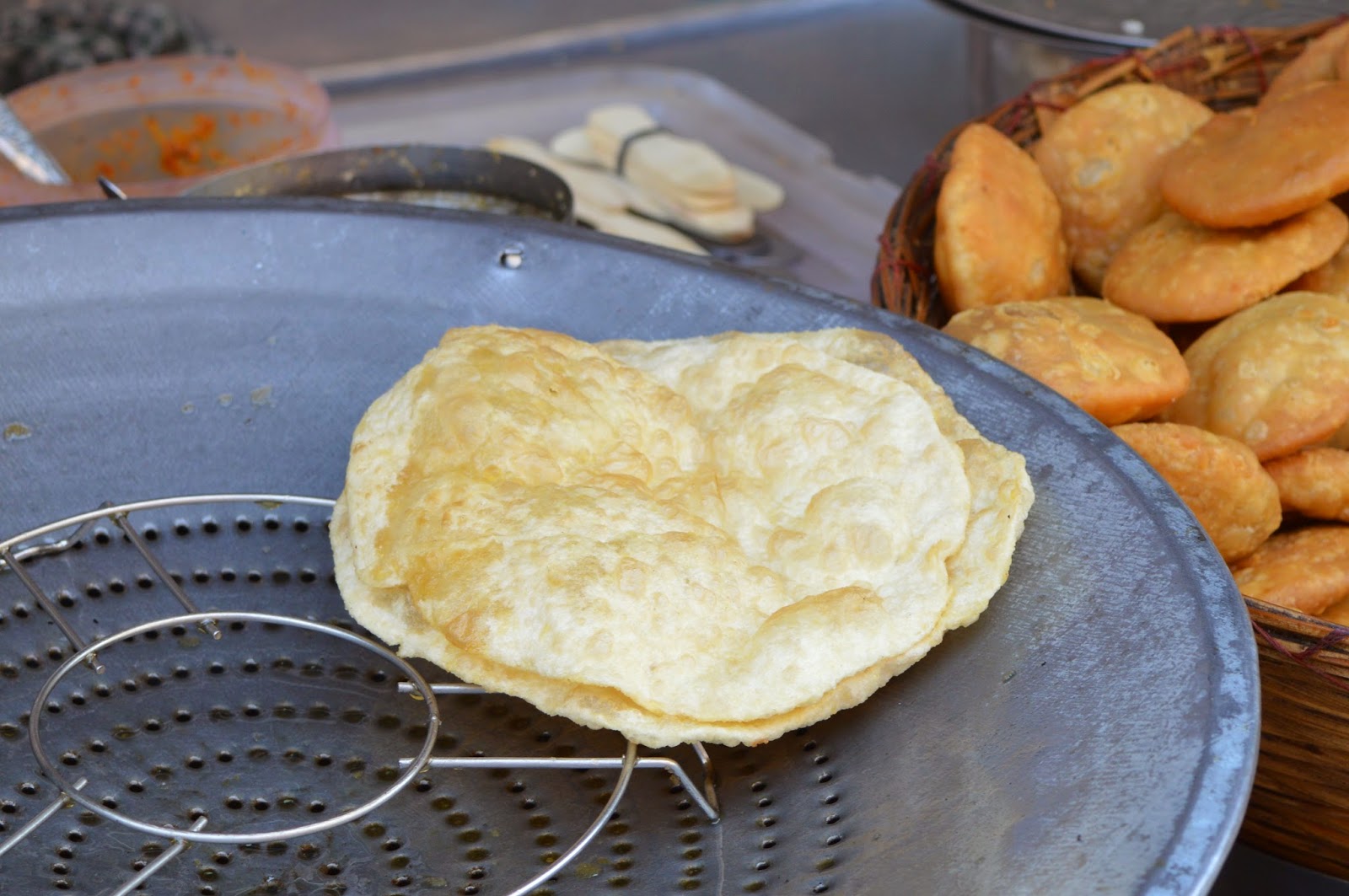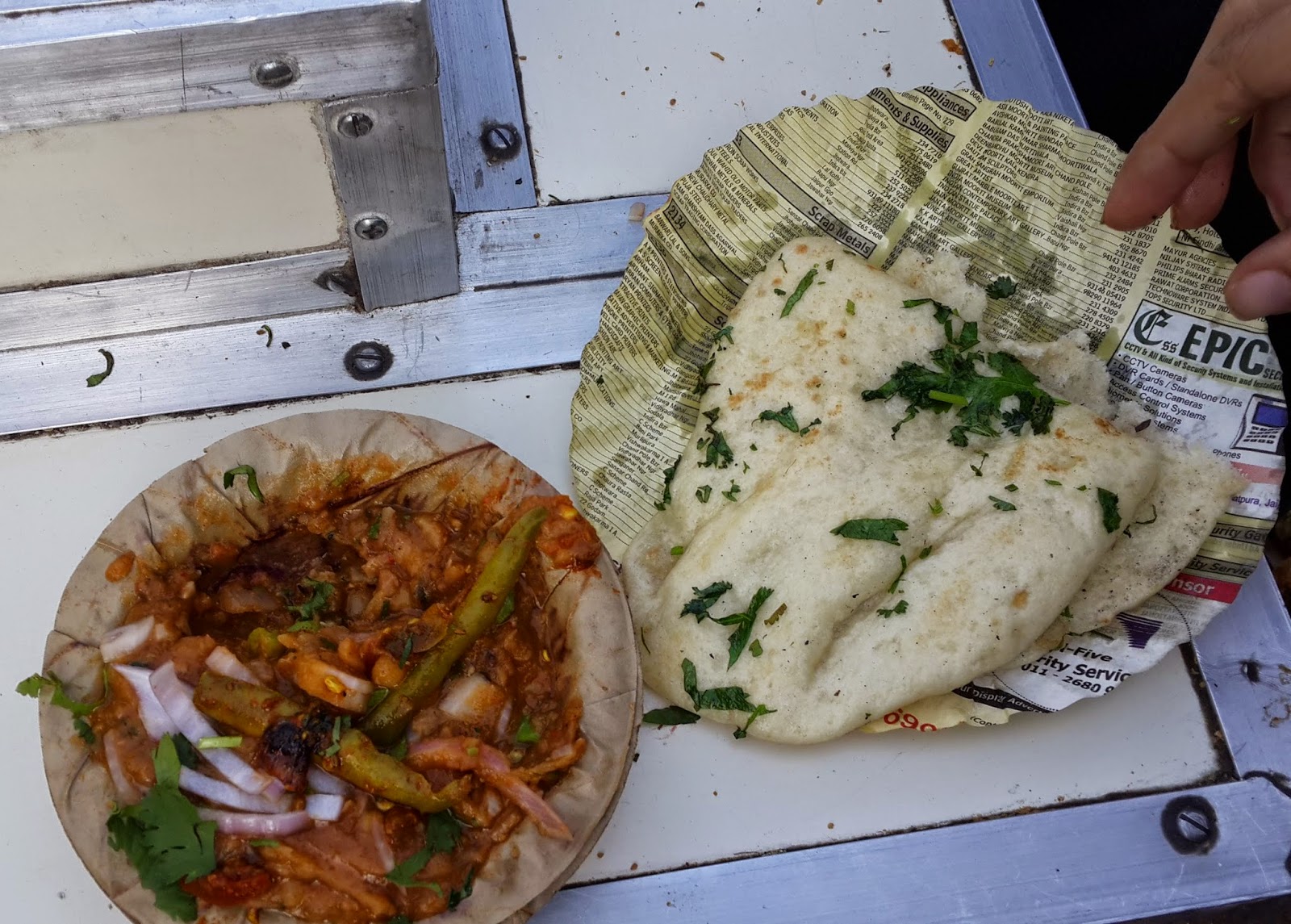This entry of our blog won't be about a specific place. Instead, it will be dedicated to one of the reasons we love India so much- the delicious (and inexpensive) street food!
A little about us:
- I'm a vegan for the last 5 years and though vegeterian food is easy to find everywhere in India, I discovered that India is probably one of the hardest places to be a vegan, on the account of dairy products which are a basic ingredient in many Indian dishes.
- Maya is kind of a vegetarian (eats fish).
There will be an oil scale for each dish ranging from
1 = almost healthy to
4 = possible heartburn.
1 = almost healthy to
4 = possible heartburn.
We'll start with the most famous item that basically you can get anywhere in India (north to south) and any time: the humble Samosa!!!!
Price: 3-10 Rs.
Main ingredients: dough, aloo (potato), green chili, green peas and spices.
Oil scale: 3-4
Main ingredients: dough, aloo (potato), green chili, green peas and spices.
Oil scale: 3-4
Variations: you can get two different types of dough (Goan is more crispy than the common Punjab), different vegetables inside and different sizes. The biggest change is if your samosa vendor has a pot of chola(chickpeas in gravy) you can have your samosa crushed by the hands of your vendor then topped with: chola, corriander sauce, ketchup, fresh onions and curd (yogurt).
*vegans try to say "no curd" in advance- sometime it works.
*vegans try to say "no curd" in advance- sometime it works.
Veg burger (!) Definitely not a traditional dish but a dish that a lot of Indians learned to love. We found stalls of it all across India.
Price: 10-30 Rs.
Main ingredients: bun, potato, ketchup(they put a lot so try to stop them).
Oil scale: 2
Main ingredients: bun, potato, ketchup(they put a lot so try to stop them).
Oil scale: 2
Variations: You can find places that deep fry the bun (like Tunisian fricasse), add fresh vegetables (don't expect pickles), or garnish with bhujia (shredded potato chips) and the main patty can be aloo tikki (see below) or a vegetable cutlet.
*Vegans: because most stalls cater to the commom pure-veg diet (which means no egg), the only problem here will be to check that they don't add a slice of cheese.
Dal vadda a great deep-fried lentil patty that you'll often find next to the samosas in the southern states (though we did see some in the north).
Price: 5-10Rs.
Main ingredients: Dal (lentils), onion, corriander (cillantro) and spices
Oil scale: 4
Price: 5-10Rs.
Main ingredients: Dal (lentils), onion, corriander (cillantro) and spices
Oil scale: 4
Puri bhaji a popular Indian breakfast item, sometimes called Puri Sabji.
Price: 10-20Rs.
Main ingredients:fried dough with potato gravy on the side.
Oil scale: 2-3
Chilly bhaji it has many different names across India and different kinds of batter but still pretty similar everywhere: a deep-fried green chili.
Price: 5-10 Rs.
Main ingredients: green chili and some kind of batter.
Oil scale: 3
Price: 10-20
Main ingredients: potato
Oil scale: 2
Oil scale: 2
Variations: you can get it in a sandwich, or just with a kind of sweet sauce but the best way to have it is mashed and mixed in chola, corriander sauce and fresh vegetables.
Price: 10-20 Rs. depending on the amount you want.
Main ingredients: chickpeas flour, some kind of vegetable and spices.
Oil scale: 3-4
Variations: it can be any vegetable like cauliflower, onion, green pepper etc. (different vegetables chopped and mixed together or pieces of individual vegetables), paneer, sea-food, chicken, rice or even bread.
 |
| Rice pakora |
Parantha- or paratha, a fried flat bread usually stuffed with veggies and served for breakfast in north India.
Price: 15-40 Rs. per peice
Main ingredients: flour, some kind of stuffing and spices
Oil scale: 3
Variations: the most common parantha is aloo (potato) paratha but you can find also: paneer, cheese, masala, gobi, mix veg and butter parantha. You can also get it plain or sweet.
*for vegans please note that it usually comes with curd (yogurt) so try in advance to ask for no curd.
*for vegans please note that it usually comes with curd (yogurt) so try in advance to ask for no curd.
Kerala Parotha or parotta a.k.a מלאווח a lovely fried flat bread that's common in the south especially in Kerala.
Price: 10-20 Rs. per piece, usually comes with a side korma (a coconut based gravy) or sabji (potato gravy)
Main ingredients: dough and oil
Oil scale: 4
Veg puff a.k.a בורקס is a great snack for the road. You can find it mostly in train and bus stations
Price: 10-20 Rs.
Main ingredients: a puff pastry filled with potatos
Oil scale: 3
Variations: some vendors open your puff and add fresh vegetables and bhujia.
Pani puri an interesting dish that's made from a hollow ball of crispy dough filld with a spoon of stuffing and swimming in pani (a watery sauce that is usually sweet and sour)
Price: 10-20 Rs. for 4 pieces
Main ingredients: the stuffing is made from vegetables and chikpeas. The sauce called pani (literaly meaning water)is made with water and different spices and herbs.
Oil scale: 1
Oil scale: 1
Veg momos steamed Tibetan dumplings that resemble Chinese dim-sum, popular all over India.
Price: 10-30 Rs. per 3-6 peices
Main ingredients: dough and different vegetables, most commonly cabbage, carrot, onion, and ginger.
Variations: fried momo, spinach and mushroom momo, cheese momo, chicken momo, seafood etc. Usually served with a spicy tomato sauce or sometimes with a clear soup.
Oil scale: 1
Variations: fried momo, spinach and mushroom momo, cheese momo, chicken momo, seafood etc. Usually served with a spicy tomato sauce or sometimes with a clear soup.
Oil scale: 1
Bhel puri/ Alu chat a popular street snack most commonly consisting of a mix puffed rice, legumes, and vegetables.
Price: 10-20 Rs. for a plate.
Main ingredients: Bhel(puffed rice),any type of legumes, vegtebles and spices.
Oil scale: 1
Poha- flattend rice dish eaten for breakfast or as snack, popular in Rajasthan.
Price: 10-20 Rs.
Main ingredients:flattened rice, curry leaves and spices.
Oil scale: 2
Variations: sometimes vegetables or chickpeas are added.
Red fish or any living thing that comes from the sea. You can find vendors selling them anywhere in India that's close to the sea.
Price: 10-50 Rs. it all depends on size and availability.
Main ingredients: fish, shrimp and crab marinated in a mix of spices and fried.
Oil scale: 3-4
Chola bhature- a tasty dish common in Rajasthan made of a type of puri (see above) and chickpeas gravy.
Price: 15-20 Rs. for chola dish and two bhature
Main ingredients: flour, chickpeas, spices and vegetables.
oil scale: 2-3
Variations: Sometimes you can find the chola served with kulcha (in the photo below) instead of bhature (for me kulcha is the better option).
Uttapam- rice pancake
Price: 20-40 Rs.
Main ingredients: rice, urad dhal, salt, fenugreek seeds, water
oil scale: 2-3
Variations: you can have it plain or with onions or veg topping. You usually get it with coconut chutney and sambar (spicy vegetable sauce) on the side.
Dosa- a south Indian rice crepe.
Price: 10-20 Rs.
Main ingredients: rice, urad dhal, salt, fenugreek seeds, water
Oil scale: 2
Variations:the most common variation is masala dosa that is filled with a potato stuffing. It is usually served with coconut chutney and sambar on the side. You can also get it with onion or cheese and in touristy places you can find sweet versions like banana coconut dosa.
Pav bhaji a bread roll with a tomato curry on the side.
Price: 10-20 Rs.
Main ingredients: roll, onion, garlic, lemon, tomato and spices
Oil scale: 3
*Vegans- try to stop them before they add butter to the bhaji.
Veg katti roll- a parantha rolled with vegetables and sauces.
Price: 10-20 Rs.
Main ingredients: parantha, vegetables, ketcup, chilli sauce
Oil scale: 3
*Vegans- sometimes they really want to add paneer (fermented cheese) to your roll so beware!
Veg chowmein - a Chinese dish popular in India and widely adopted as a street food as well as in many restaurants.
Price: 10-20 Rs.
Main ingredients:noodles (uselly spaghetti in India), cappsicum (green pepper), onion, garlic, cabbage and salt.
Oil scale: 2-3
Kachori- deep fried dough with lentil stuffing.
Price: 5-10 Rs.
Main ingredients: chickpeas flour dough filled with a stuffing of yellow dal or urad dal (white lentils) and spices.
Oil scale: 3
Variations: you can have it as is or crushed and topped with corriander sauce, sabji (vegetable gravy) and fresh veggies.
Fresh fruit
Fresh fruit
Price: 5-20 Rs. depends on which kind of fruit and the size you want.
Lemon soda stalls

*If there is a mistake regarding price (which means somebody overcharged us) or a missing ingredient, I'll be happy if you'll write to us and we will fix the mistake.
price: 10-15 Rs.
main ingredients: soda and squeezed lemon juice.
Variations: well there's not a lot of options here, but usually its drunk (by locals) as a salty drink but you can get it sweet (add sugar, but be prepared to stop the vendor from adding masala spices (?!) to your soda.

*If there is a mistake regarding price (which means somebody overcharged us) or a missing ingredient, I'll be happy if you'll write to us and we will fix the mistake.























































.JPG)
